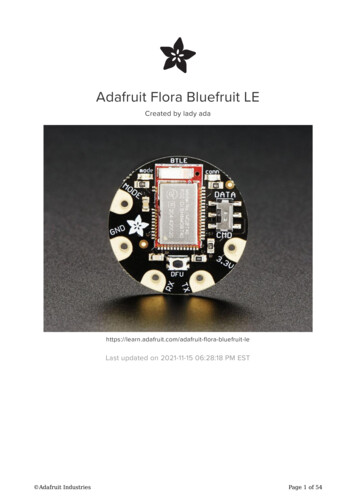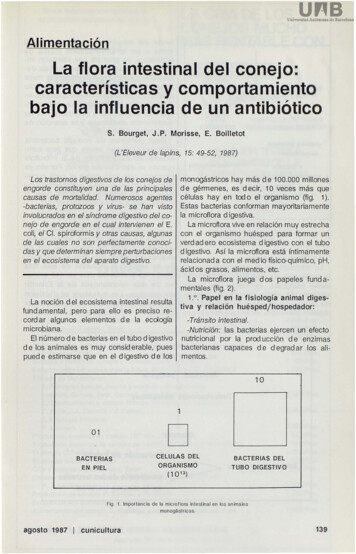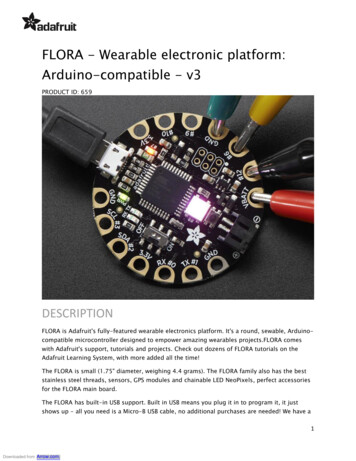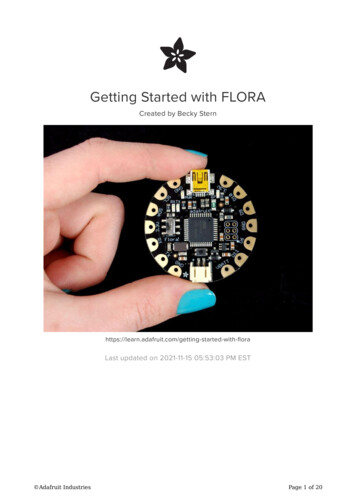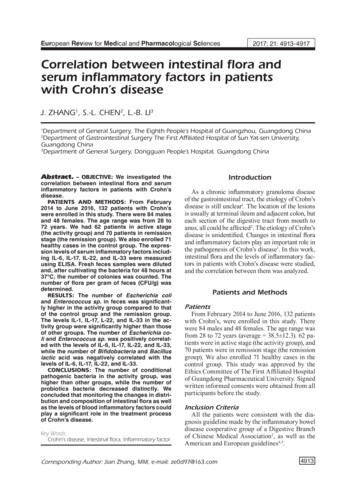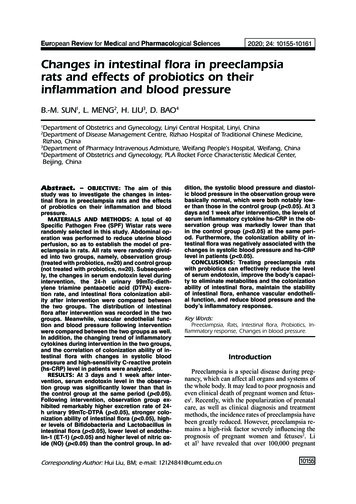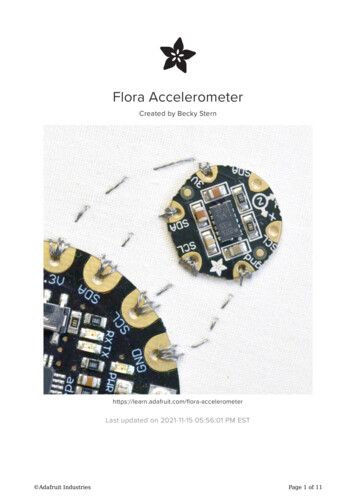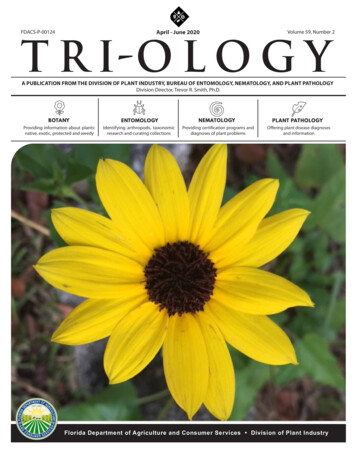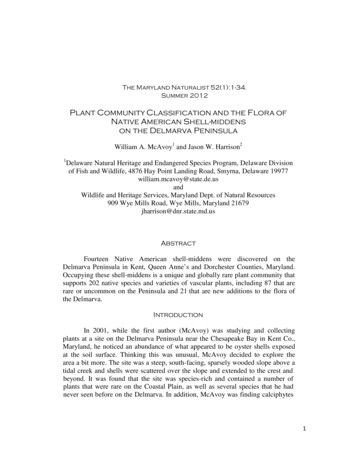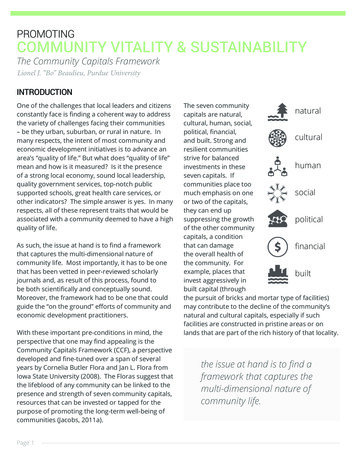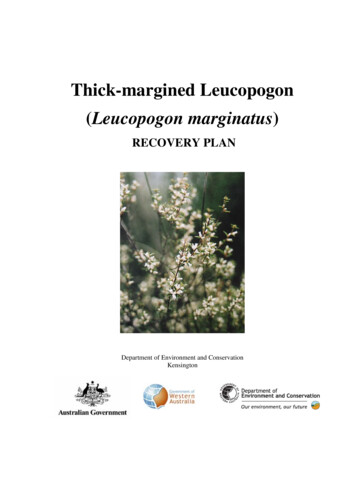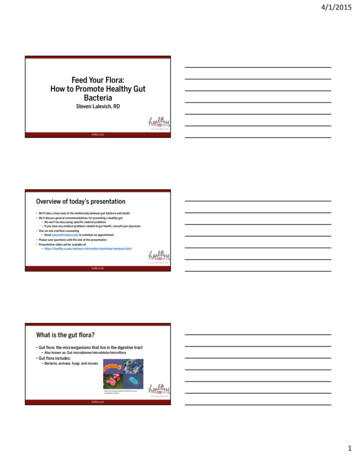
Transcription
4/1/2015Feed Your Flora:How to Promote Healthy GutBacteriaSteven Lalevich, RDhealthy.iu.eduOverview of today’s presentation We’ll take a close look at the relationship between gut bacteria and health We’ll discuss general recommendations for promoting a healthy gut We won’t be discussing specific medical problems If you have any medical problems related to gut health, consult your physician One-on-one nutrition counseling Email askanrd@indiana.edu to schedule an appointment Please save questions until the end of the presentation Presentation slides will be available at: op-handouts.htmlhealthy.iu.eduWhat is the gut flora? Gut flora: the microorganisms that live in the digestive tract Also known as: Gut microbiome/microbiota/microflora Gut flora includes: Bacteria, archaea, fungi, and an‐microbiome‐projecthealthy.iu.edu1
4/1/2015The amount of bacteria in the human body Number 100 trillion bacteria in and on your body (90% in large intestine) Bacterial cells outnumber human cells 10 to 1 (You are 90% bacteria!) Species 10,000 species of bacteria in your body 1,000 species of bacteria in your gut Weight All the bacteria in your body weigh a total of 2-6 poundshealthy.iu.eduThere are 300 times more bacteria in your gutthan there are stars in the Milky Way thy.iu.eduBeyond the gut Digestive tract Skin Mouth Nose Ears Eyes Genitals Respiratory tracthttp://www.genome.gov/dmd/img.cfm?node Photos/Graphics&id 85320healthy.iu.edu2
4/1/2015Microbiome as Ecosystem Variety of species interacting with each other Species may compete with each other for same food source One species’ waste is another species’ dinner Increasing/decreasing population of one species may affect many others Different ecosystem in different locations Food sources, acidity (pH), temperature, and humidity Different bacteria thrive in different conditions Small alterations can have massive effects on the 186033207healthy.iu.edu3
4/1/2015Functions of the gut microbiome Regulates immune function Prevents growth of harmful microorganisms Fermentation of indigestible food (fiber) Production of nutrients Vitamin K2 B vitamins Short chain fatty acids (SCFA) Influences hormone and neurotransmitter productionhealthy.iu.eduHealth effects of an altered gut microbiome Impaired immune function Increased susceptibility to infection Allergies and auto-immune conditions may be related to altered microbiome Increased inflammation, both in the gut and systemically Increases risk of chronic diseases and obesity Aging Gut microbiota in older adults is significantly different from young adults Altered brain functionhealthy.iu.eduGut Bacteria & The Brain Gut bacteria impact many brain functions Sleep regulationMoodPain sensitivityAppetite regulation Stress Bacteria may influence stress response Stress response may alter the microbiomehealthy.iu.edu4
4/1/2015The development of the microbiome Begins at birth Vaginal birth: exposure to vaginal and intestinal microbes C-sections: minimal bacterial exposure Correlate with increased risk of allergies and auto-immune conditions Breastfeeding Prebiotics (food for gut bacteria): oligosaccharides Probiotics (live bacteria that populates gut): beneficial bacteriahealthy.iu.eduAntibiotic Use An average child is prescribed antibiotics 10-20 times by the age of18 Antibiotics are often necessary, but their use alters the microbiome The microbiome may never recover from these changes This may contribute to increased risk of many ws/jan13/antibiotics.htmlhealthy.iu.eduSterile modern lifestyle – Are we too clean? Antibacterial soaps and cleaners Spending 90% or more of our time indoors Aversion to getting dirty Lack of beneficial bacteria in food supply Abundance of beneficial bacteria found in dirt/soil Bacteria is reduced in thoroughly washed or highly processed foods Dishwashershealthy.iu.edu5
4/1/2015Ways to promote a healthy skin microbiome Get a dog Swim in a natural body of water Spend more time outdoors Open your windows Get your hands dirty (with actual .htmlhealthy.iu.eduFood & The Microbiome Dietary changes can significantly alter the microbiome within 24hours The gut microbiome impacts nutrient absorption and production Unhealthy diet consequences Nutritional deficiencies from poor diet Nutritional deficiencies from altered microbiome Decreased absorption Decreased x?id 686737healthy.iu.eduFeed your Flora with Fiber Gut bacteria eat (ferment) fiber. Whole plant foods are main sources of fiber VegetablesFruitsWhole grainsBeans and legumesNuts and re‐fruits Association between high fiber diet and reduced risk of: Obesity Heart disease Cancerhealthy.iu.edu6
4/1/2015Types of Fiber Fermentable (feeds your gut bacteria) Soluble fiber: Onions, oats, nuts, apples, fruits, vegetables Resistant starch: Unripe bananas, oats, beans, cooked and cooled starches Non-fermentable (increases stool bulk) Insoluble fiber: Whole grains, nuts, fruits, vegetables Most plant foods contain a combination of soluble and insoluble fiber. Some bowel conditions may require restriction of fermentable fiber.healthy.iu.eduTypes of Soluble Fiber Inulin Garlic, onion, leek, artichoke, asparagus Pectin Pears, apples, plums, oranges (and other citrus fruits) Raffinose Beans, cabbage, broccoli, Brussels sprouts Eating a variety of soluble fiber sources promotes diversity of gutspecies.healthy.iu.eduInflammation, polyphenols, and gut bacteria Less inflammation a healthier gut Polyphenols (plant-based antioxidant compounds) Anti-inflammatory effects Gut bacteria promote polyphenol absorption Polyphenols promote growth and diversity of healthy microbiome Sources of polyphenols: Whole plant foods: vegetables, fruits, whole grains, nuts, beans,seeds, etc. Herbs and spices: garlic, turmeric, ginger, cinnamon, oregano,rosemary, etc. Others: tea, coffee, dark chocolate, red wine, extra virgin olive oilhealthy.iu.edu7
4/1/2015Probiotics & Gut Health May be beneficial for some conditions but research results are mixed Irritable bowel syndromeInflammatory bowel disease (Crohn’s disease, ulcerative colitis)DiarrheaConstipation Adverse effects Probiotics may worsen symptoms in some individuals Immunocompromised should not use probiotics without medical supervision Effects may vary based on species, strain, combination, andprebioticshealthy.iu.eduPrebiotics Prebiotics feed gut bacteria Fermentable fiber in foods Prebiotic supplements Types of supplemental prebiotics: Fructo-oligosaccharide (FOS) Mannan-oligosaccharide (MOS) Galacto-oligosaccharide (GOS)healthy.iu.eduChoosing a Probiotic In one study, only 1 out of 14 probiotic supplements contained exactlywhat was listed on the label (some had more, some had less) Even the best probiotics may not make it to the gut intact. If taking probiotics, you should: Buy from a reliable sourceCompare the CFUs (colony forming units)Keep refrigerated to maximize shelf lifeUse before expiration datehealthy.iu.edu8
4/1/2015Fermented Foods Fermented foods may act as natural probiotics Fermentation is a traditional way of preserving food Fermented foods include: Dairy: yogurt, kefir Vegetables: sauerkraut, kimchi, pickles Soy: miso, tempeh Not all versions of these foods act as probiotics. Check the label.healthy.iu.eduArtificial Sweetener Artificial sweeteners may cause alterations in the microbiome thatlead to glucose intolerance and metabolic events/features/glucose.htmlhealthy.iu.eduAvoid produce with high pesticide residueshealthy.iu.edu9
4/1/2015Putting together a healthy diet Does your diet feed only 10% of you? 90% of your cells are bacteria Make sure you are feeding them! Eat more plants (greater quantity and variety) Aim for consuming at least 30 different plantspecies per week Limit intake of highly processed foods due to: Lack of fermentable fiber Potentially harmful effects of chemical additivesand merUpdates/ucm262031.htmhealthy.iu.eduVitamin D Vitamin D is another important regulator of the immune system Vitamin D deficiency is common (42% of U.S. population) May alter the gut microbiome May trigger immune response to “good” bacteria Associated with increased inflammation in the gut Sources of vitamin D Sunlight Food: fatty fish, eggs, fortified foods (milk, cereal, etc.) Supplementation Testing your Vitamin D statushealthy.iu.eduCircadian Rhythm Circadian rhythm: body’s internal 24-hour clock Gut bacteria have circadian rhythms too! Disrupting normal sleep-wake cycle may: Alter the microbiome Increase risk of obesity and chronic ��relaxation‐rejuvenate‐body‐mind.aspx Gut microbiome composition varies depending on the time ofday Less variation is observed in obesity Correcting circadian rhythm disruption may help restore thecircadian rhythm of the gut microbiome and promote normalmetabolismhealthy.iu.edu10
4/1/2015Correcting your Circadian Rhythm Light Avoid artificial light exposure at night Spend time outdoors during the daytime Food intake Avoid eating late at night (stop eating within 3-4 hours of bedtime) Start your day with a healthy breakfast Get at least 7-8 hours of sleep each night Sleep is also important for limiting inflammation Watch “Reset your Rhythm” presentation for more information op-handouts.htmlhealthy.iu.eduTest your own gut bacteria American Gut Project http://humanfoodproject.com/americangut/ uBiome http://ubiome.com/ Both use results anonymously for research purposes Results are not intended to diagnose or treat any medical i/Bristol stool scale#/media/File:Bristol stool chart.svghealthy.iu.edu11
4/1/2015Constipation Approximately 15% of the U.S. population experiences chronicconstipation Altered microbiome Constipation Dietary factors Fiber Water Lifestyle factors Physical activity Stress Toilet posture: sitting vs. squattinghttp://www.slate.com/articles/health and science/science/2010/08/dont just sit there.htmlhealthy.iu.eduSquatting is a more natural posture thansitting Greater hip flexion straighter recto-anal canal easierelimination Squatting may reduce risk of constipation, hemorrhoids, PENSEURhealthy.iu.eduSquat toilethealthy.iu.edu12
4/1/2015Toilet platformNature's PlatformTMhealthy.iu.eduToilet StoolSquatty PottyTMhealthy.iu.eduHow to improve your toilet dfhealthy.iu.edu13
4/1/2015How to improve your toilet dfhealthy.iu.eduHow to improve your toilet dfhealthy.iu.eduHow to improve your toilet dfhealthy.iu.edu14
4/1/2015Feed Your Flora Tips Diet Eat a whole food based diet that includes good sources of fiberConsume at least 30 different plant species each weekInclude fermented foods in your dietAvoid intake of highly processed foodsAvoid artificial Feed Your Flora Tips Lifestyle Incorporate stress management practices into your daily routineEngage in regular physical activitySpend more time outdoorsCorrect circadian rhythm disruptionConsider squatting instead of erences American Chemical Society. The precise reason for the health benefits of dark chocolate: mystery solved. ewsreleases/2014/ f-darkchocolate-mystery-solved.html Blaser M. Antibiotic overuse: Stop the killing of beneficial bacteria. Nature. 2011;476(7361):393-4. Forrest KY, Stuhldreher WL. Prevalence and correlates of vitamin D deficiency in US adults. Nutr Res. 2011;31(1):48-54. Galland L. The gut microbiome and the brain. J Med Food. 2014;17(12):1261-72. Joyce SA, Gahan CG. The gut microbiota and the metabolic health of the host. Curr Opin Gastroenterol. 2014;30(2):120-7. The Low FODMAP Diet. Standford Hospital & Clinics: ition-services/docs/pdf-lowfodmapdiet.pdf Marcobal A, Underwood MA, Mills DA. Rapid determination of the bacterial composition of commercial probiotic products byterminal restriction fragment length polymorphism analysis. J Pediatr Gastroenterol Nutr. 2008;46(5):608-11. O'mahony SM, Clarke G, Borre YE, Dinan TG, Cryan JF. Serotonin, tryptophan metabolism and the brain-gut-microbiome axis.Behav Brain Res. 2015;277:32-48. Picard C, Fioramonti J, Francois A, Robinson T, Neant F, Matuchansky C. Review article: bifidobacteria as probiotic agents -physiological effects and clinical benefits. Aliment Pharmacol Ther. 2005;22(6):495-512.healthy.iu.edu15
4/1/2015References Pollan M. Some of my best friends are germs. New York Times. 2013. icrobiome.html?pagewanted all& r 1& Queipo-ortuño MI, Boto-ordóñez M, Murri M, et al. Influence of red wine polyphenols and ethanol on the gut microbiota ecologyand biochemical biomarkers. Am J Clin Nutr. 2012;95(6):1323-34. Ramirez-farias C, Slezak K, Fuller Z, Duncan A, Holtrop G, Louis P. Effect of inulin on the human gut microbiota: stimulation ofBifidobacterium adolescentis and Faecalibacterium prausnitzii. Br J Nutr. 2009;101(4):541-50. Reardon S. Gut-brain link grabs neuroscientists. Nature. 2014;515(7526):175-7. Siener R, Bangen U, Sidhu H, Hönow R, Von unruh G, Hesse A. The role of Oxalobacter formigenes colonization in calcium oxalatestone disease. Kidney Int. 2013;83(6):1144-9. Sikirov D. Comparison of straining during defecation in three positions: results and implications for human health. Dig Dis Sci.2003;48(7):1201-5. Suez J, Korem T, Zeevi D, et al. Artificial sweeteners induce glucose intolerance by altering the gut microbiota. Nature.2014;514(7521):181-6. Wu GD, Chen J, Hoffmann C, et al. Linking long-term dietary patterns with gut microbial enterotypes. ns?For additional questions, or to schedule a one‐on‐one nutritioncounseling appointment, email: askanrd@indiana.eduhealthy.iu.edu16
4/1/2015 2 healthy.iu.edu The amount of bacteria in the human body Number 100 trillion bacteria in and on your body (90% in large intestine) Bacterial cells outnumber human cells 10 to 1 (You are 90% bacteria!)
